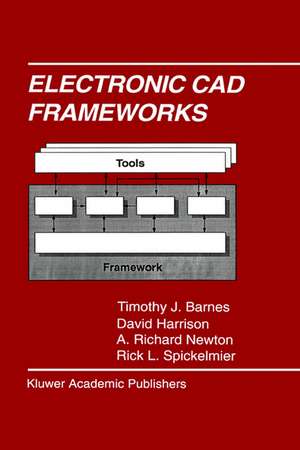Electronic CAD Frameworks: The Springer International Series in Engineering and Computer Science, cartea 185
Autor Timothy J. Barnes, David Harrison, A. Richard Newton, Rick L. Spickelmieren Limba Engleză Hardback – 30 iun 1992
| Toate formatele și edițiile | Preț | Express |
|---|---|---|
| Paperback (1) | 636.63 lei 43-57 zile | |
| Springer Us – 9 oct 2012 | 636.63 lei 43-57 zile | |
| Hardback (1) | 642.83 lei 43-57 zile | |
| Springer Us – 30 iun 1992 | 642.83 lei 43-57 zile |
Din seria The Springer International Series in Engineering and Computer Science
- 24%
 Preț: 1041.98 lei
Preț: 1041.98 lei - 20%
 Preț: 643.50 lei
Preț: 643.50 lei - 18%
 Preț: 1225.62 lei
Preț: 1225.62 lei - 18%
 Preț: 965.02 lei
Preț: 965.02 lei - 20%
 Preț: 646.12 lei
Preț: 646.12 lei - 18%
 Preț: 948.79 lei
Preț: 948.79 lei - 20%
 Preț: 646.62 lei
Preț: 646.62 lei - 15%
 Preț: 637.46 lei
Preț: 637.46 lei - 20%
 Preț: 643.83 lei
Preț: 643.83 lei - 18%
 Preț: 949.23 lei
Preț: 949.23 lei - 20%
 Preț: 644.48 lei
Preț: 644.48 lei - 20%
 Preț: 994.92 lei
Preț: 994.92 lei - 20%
 Preț: 645.97 lei
Preț: 645.97 lei - 18%
 Preț: 946.87 lei
Preț: 946.87 lei - 20%
 Preț: 995.57 lei
Preț: 995.57 lei - 18%
 Preț: 956.99 lei
Preț: 956.99 lei - 20%
 Preț: 644.98 lei
Preț: 644.98 lei - 15%
 Preț: 649.54 lei
Preț: 649.54 lei - 18%
 Preț: 950.21 lei
Preț: 950.21 lei - 18%
 Preț: 1221.38 lei
Preț: 1221.38 lei - 18%
 Preț: 957.62 lei
Preț: 957.62 lei - 15%
 Preț: 643.99 lei
Preț: 643.99 lei - 18%
 Preț: 948.47 lei
Preț: 948.47 lei - 18%
 Preț: 947.35 lei
Preț: 947.35 lei - 20%
 Preț: 1284.65 lei
Preț: 1284.65 lei - 20%
 Preț: 1628.31 lei
Preț: 1628.31 lei - 20%
 Preț: 1285.78 lei
Preț: 1285.78 lei
Preț: 642.83 lei
Preț vechi: 756.27 lei
-15% Nou
Puncte Express: 964
Preț estimativ în valută:
123.04€ • 133.70$ • 103.42£
123.04€ • 133.70$ • 103.42£
Carte tipărită la comandă
Livrare economică 21 aprilie-05 mai
Preluare comenzi: 021 569.72.76
Specificații
ISBN-13: 9780792392521
ISBN-10: 0792392523
Pagini: 195
Ilustrații: XVII, 195 p.
Dimensiuni: 155 x 235 x 14 mm
Greutate: 0.49 kg
Ediția:1992
Editura: Springer Us
Colecția Springer
Seria The Springer International Series in Engineering and Computer Science
Locul publicării:New York, NY, United States
ISBN-10: 0792392523
Pagini: 195
Ilustrații: XVII, 195 p.
Dimensiuni: 155 x 235 x 14 mm
Greutate: 0.49 kg
Ediția:1992
Editura: Springer Us
Colecția Springer
Seria The Springer International Series in Engineering and Computer Science
Locul publicării:New York, NY, United States
Public țintă
ResearchCuprins
1: Introdution.- 1.1 The Nature of a CAD Framework.- 1.2 The Evolution of CAD Frameworks.- 1.3 CAD Frameworks and Openness.- 1.4 The Rise of Commercial CAD Frameworks.- 1.5 The Impact of Object-Oriented Techniques.- 1.6 The Standardization of CAD Frameworks.- 1.7 Organization of the Book.- 2: Major Components of an Engineering Framework.- 2.1 Overview.- 2.2 Operating System Services.- 2.3 Tool Integration and Encapsulation.- 2.4 Design Management.- 3: Data Representation.- 3.1 Introduction.- 3.2 Databases and Data Structures.- 3.3 Approaches to CAD Databases.- 3.4 Representational Issues.- 3.5 The Nature of Engineering Design Information.- 3.6 Hierarchy.- 4: Data Management.- 4.1 Introduction.- 4.2 Conventional Database Approaches.- 4.3 Physical Versus Logical Data Management.- 4.4 Managing the History of a Design.- 4.5 Managing Multiple Users of the Data.- 4.6 Concurrency Control.- 4.7 Compatibility with Change.- 5: Tool Management.- 5.1 Introduction.- 5.2 Tool Characterization.- 5.3 Tool Control.- 5.4 Other Tool Management Functions.- 6: Design Flow Management.- 6.1 Introduction.- 6.2 Benefits.- 6.3 DFM Dependencies.- 6.4 Existing Approaches.- 6.5 Describing the Design Flow.- 6.6 The Design Flow Engine.- 6.7 Standardization and Design Flow Management.- 7: User Interfaces.- 7.1 Introduction.- 7.2 History of Design Automation User Interface Systems.- 7.3 Modern Framework User Interfaces.- 7.4 Future Directions for CAD User Interfaces.- 8: Extension Languages.- 8.1 Introduction.- 8.2 Commercial Extension Languages in CAD.- 8.3 Extension Languages Prototypes.- 8.4 Extension Languages Requirements.- 8.5 Design Issues for Extension Languages.- 8.6 General Applications of Extension Languages.- 8.7 Language-Based Design.- 8.8 Benefits of an Extension Language.- 8.9 Future Directions.- 9: Implementing a CAD Framework.- 9.1 Introduction.- 9.2 The CODEM Approach.- 9.3 Commercial Frameworks.- 10: The CAD Framework Initiative.- 10.1 Introduction.- 10.2 The Origins of CFI.- 10.3 Goals and Deliverables.- 10.4 The CFI Organization.- 10.5 Tangible and Intangible Benefits.- 10.6 Technical Activities.- 10.7 CFI in the Future.- 11: Summary.- 11.1 Acknowledgments.- References.













